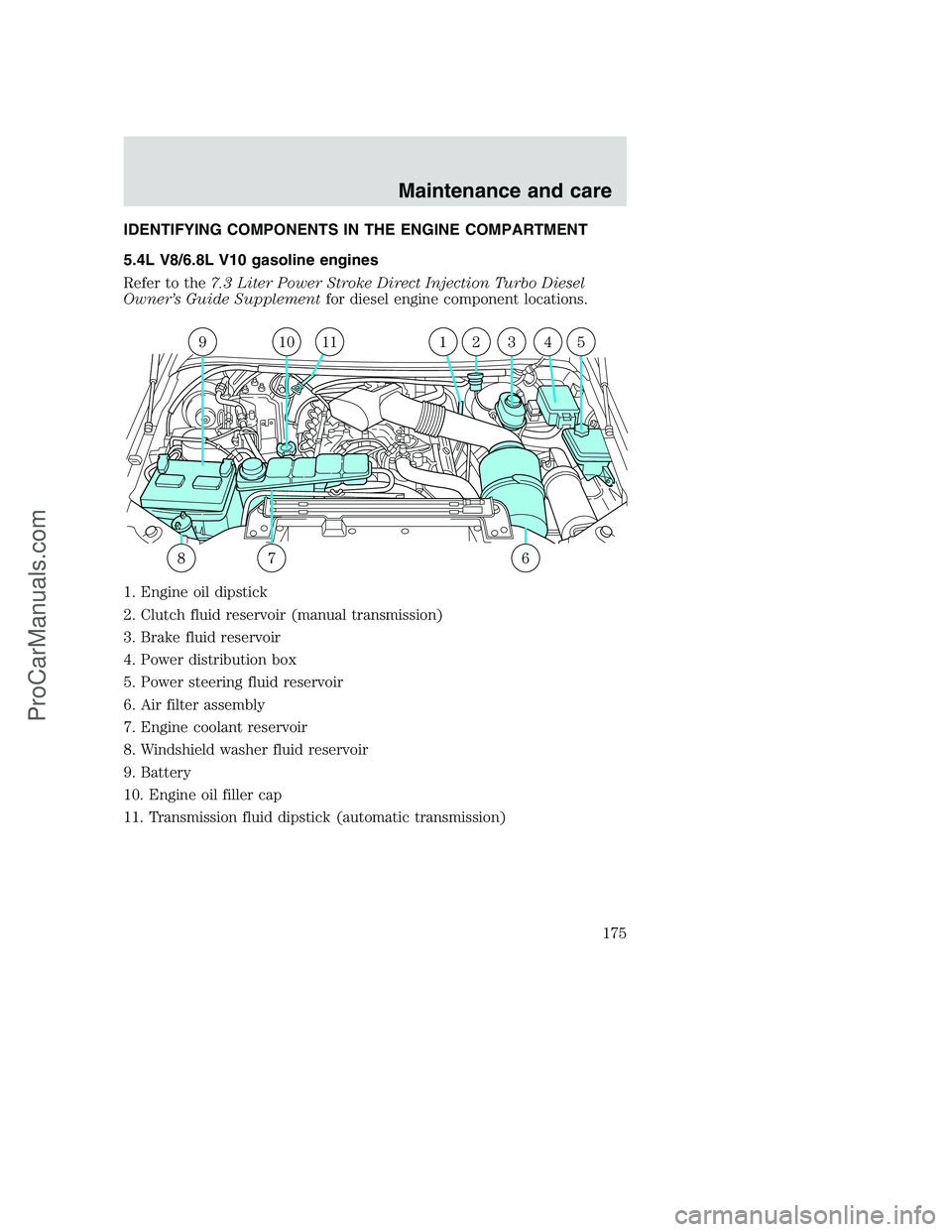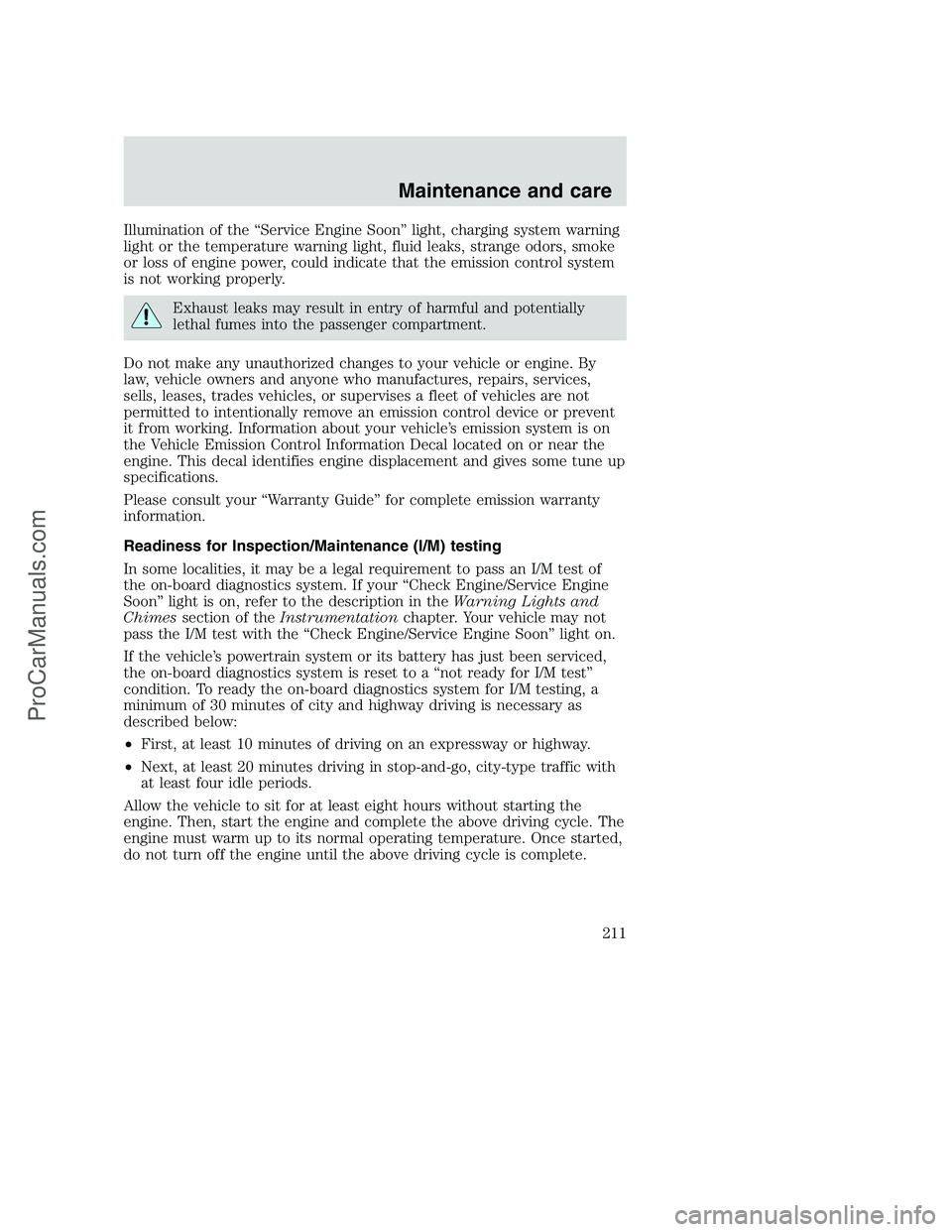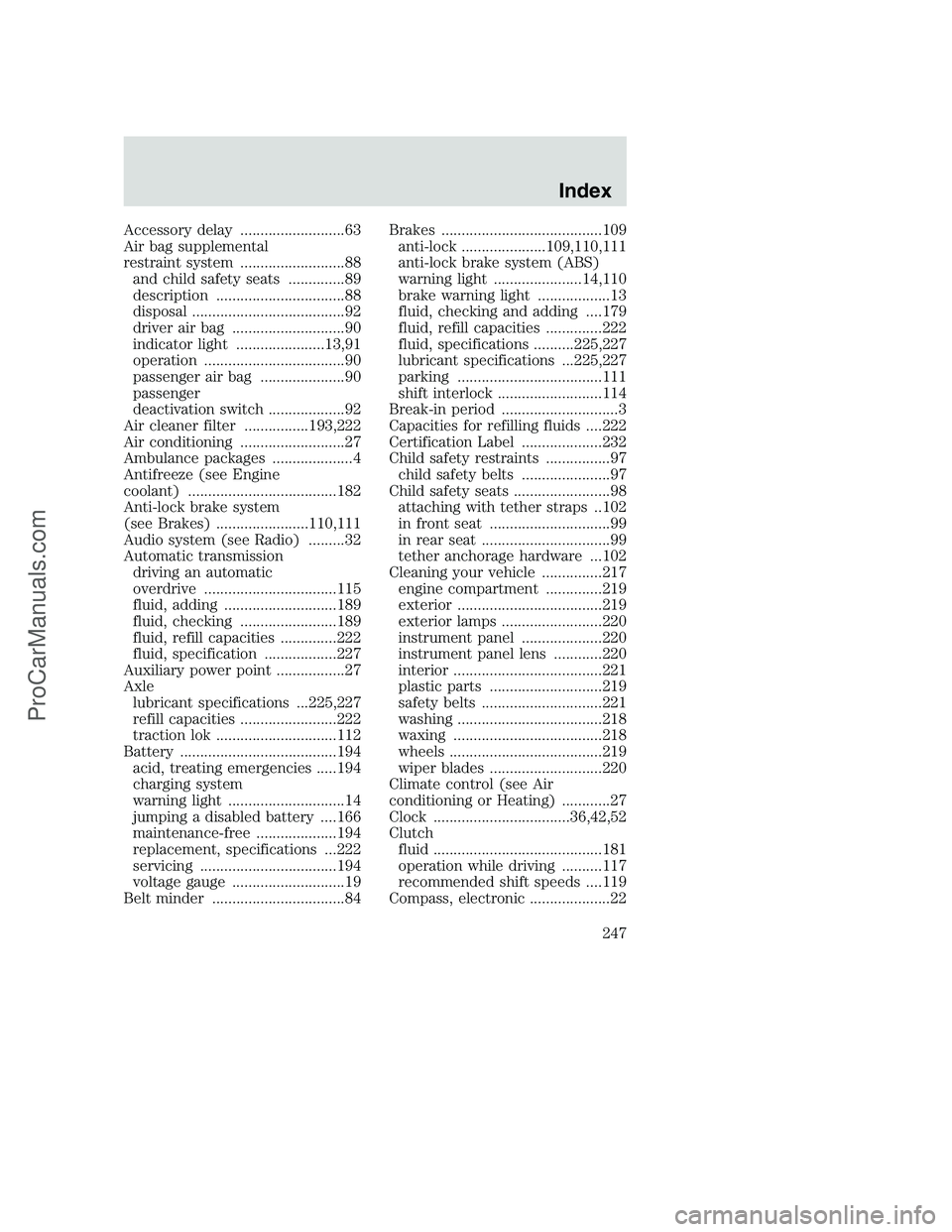2000 FORD F250 battery
[x] Cancel search: batteryPage 175 of 256

IDENTIFYING COMPONENTS IN THE ENGINE COMPARTMENT
5.4L V8/6.8L V10 gasoline engines
Refer to the7.3 Liter Power Stroke Direct Injection Turbo Diesel
Owner’s Guide Supplementfor diesel engine component locations.
1. Engine oil dipstick
2. Clutch fluid reservoir (manual transmission)
3. Brake fluid reservoir
4. Power distribution box
5. Power steering fluid reservoir
6. Air filter assembly
7. Engine coolant reservoir
8. Windshield washer fluid reservoir
9. Battery
10. Engine oil filler cap
11. Transmission fluid dipstick (automatic transmission)
910111234
867
5
Maintenance and care
175
ProCarManuals.com
Page 194 of 256

2. Carefully separate the two halves
of the air filter housing.
3. Remove the air filter element
from the open end of the air filter
housing.
4. Install a new air filter element, ensuring the arrow on the top half of
the air filter housing lines up with the notch on the bottom half of air
filter housing. Be careful not to crimp the filter element edges between
the air filter housing. This could cause filter damage and allow
unmetered air to enter the engine if not properly seated.
5. Replace the two halves of the air filter housing and secure the clamp.
DRIVELINE UNIVERSAL JOINT AND SLIP YOKE
Your vehicle may be equipped with universal joints that require
lubrication. Refer to the Scheduled Maintenance Guide for maintenance
intervals. If the original universal joints are replaced with universal joints
equipped with grease fittings, lubrication will also be necessary.
BATTERY
Your vehicle is equipped with a
Motorcraft maintenance-free battery
which normally does not require
additional water during its life of
service.
Maintenance and care
194
ProCarManuals.com
Page 195 of 256

However, for severe usage or in high temperature climates, check the
battery electrolyte level. Refer to the Scheduled Maintenance Guide for
the service interval schedules.
Keep the electrolyte level in each cell up to the “level indicator”.
Do not overfill the battery cells.
If the electrolyte level in the battery is low, you can add plain tap water
to the battery, as long as you do not use hard water (water with a high
mineral or alkali content). If possible, however, try to only fill the battery
cells with distilled water. If the battery needs water often, have the
charging system checked.
If your battery has a cover/shield, make sure it is reinstalled
after the battery has been cleaned or replaced.
For longer, trouble-free operation, keep the top of the battery clean and
dry. Also, make certain the battery cables are always tightly fastened to
the battery terminals.
If you see any corrosion on the battery or terminals, remove the cables
from the terminals and clean with a wire brush. You can neutralize the
acid with a solution of baking soda and water.
Batteries normally produce explosive gases which can cause
personal injury. Therefore, do not allow flames, sparks or lighted
substances to come near the battery. When working near the battery,
always shield your face and protect your eyes. Always provide proper
ventilation.
When lifting a plastic-cased battery, excessive pressure on the
end walls could cause acid to flow through the vent caps,
resulting in personal injury and/or damage to the vehicle or battery.
Lift the battery with a battery carrier or with your hands on opposite
corners.
Keep batteries out of reach of children. Batteries contain sulfuric
acid. Avoid contact with skin, eyes or clothing. Shield your eyes
when working near the battery to protect against possible splashing of
acid solution. In case of acid contact with skin or eyes, flush
immediately with water for a minimum of 15 minutes and get prompt
medical attention. If acid is swallowed, call a physician immediately.
Maintenance and care
195
ProCarManuals.com
Page 196 of 256

Because your vehicle’s engine is also electronically controlled by a
computer, some control conditions are maintained by power from the
battery. When the battery is disconnected or a new battery is installed,
the engine must relearn its idle and fuel trim strategy for optimum
driveability and performance. To begin this process:
1. With the vehicle at a complete stop, set the parking brake.
2. Put the gearshift in P (Park) (automatic transmission) or the neutral
position (manual transmission), turn off all accessories and start the
engine.
3. Run the engine until it reaches normal operating temperature.
4. Allow the engine to idle for at least one minute.
5. Turn the A/C on and allow the engine to idle for at least one minute.
6. Drive the vehicle to complete the relearning process.
•The vehicle may need to be driven 16 km (10 miles) or more to
relearn the idle and fuel trim strategy.
•If you do not allow the engine to relearn its idle trim, the idle
quality of your vehicle may be adversely affected until the idle
trim is eventually relearned.
If the battery has been disconnected or a new battery has been installed,
the clock and the preset radio stations must be reset once the battery is
reconnected.
•Always dispose of automotive
batteries in a responsible manner.
Follow your local authorized
standards for disposal. Call your
local authorized recycling center
to find out more about recycling
automotive batteries.
WINDSHIELD WIPER BLADES
Check the wiper blades at least twice a year or when they seem less
effective. Substances such as tree sap and some hot wax treatments used
by commercial car washes reduce the effectiveness of wiper blades.
LEAD
RETURN
RECYCLE
Maintenance and care
196
ProCarManuals.com
Page 211 of 256

Illumination of the “Service Engine Soon” light, charging system warning
light or the temperature warning light, fluid leaks, strange odors, smoke
or loss of engine power, could indicate that the emission control system
is not working properly.
Exhaust leaks may result in entry of harmful and potentially
lethal fumes into the passenger compartment.
Do not make any unauthorized changes to your vehicle or engine. By
law, vehicle owners and anyone who manufactures, repairs, services,
sells, leases, trades vehicles, or supervises a fleet of vehicles are not
permitted to intentionally remove an emission control device or prevent
it from working. Information about your vehicle’s emission system is on
the Vehicle Emission Control Information Decal located on or near the
engine. This decal identifies engine displacement and gives some tune up
specifications.
Please consult your “Warranty Guide” for complete emission warranty
information.
Readiness for Inspection/Maintenance (I/M) testing
In some localities, it may be a legal requirement to pass an I/M test of
the on-board diagnostics system. If your “Check Engine/Service Engine
Soon” light is on, refer to the description in theWarning Lights and
Chimessection of theInstrumentationchapter. Your vehicle may not
pass the I/M test with the “Check Engine/Service Engine Soon” light on.
If the vehicle’s powertrain system or its battery has just been serviced,
the on-board diagnostics system is reset to a “not ready for I/M test”
condition. To ready the on-board diagnostics system for I/M testing, a
minimum of 30 minutes of city and highway driving is necessary as
described below:
•First, at least 10 minutes of driving on an expressway or highway.
•Next, at least 20 minutes driving in stop-and-go, city-type traffic with
at least four idle periods.
Allow the vehicle to sit for at least eight hours without starting the
engine. Then, start the engine and complete the above driving cycle. The
engine must warm up to its normal operating temperature. Once started,
do not turn off the engine until the above driving cycle is complete.
Maintenance and care
211
ProCarManuals.com
Page 222 of 256

MOTORCRAFT PART NUMBERS
Component* 5.4L V8 engine 6.8L V10 engine
Air filter element FA-1634 FA-1634
Fuel filter FG-986B FG-986B
Oil filter FL-820-S FL-820-S
PCV valve EV-233 EV-233
Battery (Standard) BXT-65-650 BXT-65-650
Battery (Optional) BXT-65-750 BXT-65-750
Spark plugs-platinum** AWSF-22E AWSF-22E
*Refer to the7.3 Liter Power Stroke Direct Injection Turbo Diesel
Owner’s Guide Supplementfor Motorcraft diesel engine service part
numbers.
**Refer to Vehicle Emissions Control Information (VECI) decal for spark
plug gap information.
REFILL CAPACITIES
FluidFord Part
NameApplication Capacity
Front axle Motorcraft SAE
75W-90
Premium 4x4
Front Axle
LubricantF-250/350 Dana
50 axle1.8L (3.8 pints)
F-350/450/550
Dana 60 axle2.7L (5.8 pints)
Rear axle
1,2Motorcraft SAE
75W-140
Synthetic Rear
Axle LubricantF-250 /350
(10.50 inch
axle)3.3L (6.9 pints)
Motorcraft SAE
80W-90
Premium Rear
Axle LubricantF-550 Dana 135 11.6L
(24.5 pints)
Brake fluid High
Performance
DOT 3 Motor
Vehicle Brake
FluidAll Fill to line on
reservoir
Capacities and specifications
222
ProCarManuals.com
Page 243 of 256

Comfort and convenience
Air conditioner
Bed web net
Cargo nets
Cargo organizers
Cargo storage bin
Cargo trays
Engine block heaters
Power sliding rear window
Tire step
Travel equipment
Auto headlamp system with Daytime Running Lights (DRL)
Bumper mounted bike courier
Daytime running lights (DRL)
Electrochromic inside mirror with compass
Electrochromic inside mirror with compass and temperature display
Fog lights
Framed luggage covers
Heavy-duty battery
Off road lights
Pickup box rails
Running boards and tubular running bars
Speed control
Towing mirrors
Trailer hitch, Class IV
Trailer hitch bars and balls
Trailer hitch mounted bike carrier
Trailer hitch wiring adaptor
Trailer wiring harness
Customer assistance
243
ProCarManuals.com
Page 247 of 256

Accessory delay ..........................63
Air bag supplemental
restraint system ..........................88
and child safety seats ..............89
description ................................88
disposal ......................................92
driver air bag ............................90
indicator light ......................13,91
operation ...................................90
passenger air bag .....................90
passenger
deactivation switch ...................92
Air cleaner filter ................193,222
Air conditioning ..........................27
Ambulance packages ....................4
Antifreeze (see Engine
coolant) .....................................182
Anti-lock brake system
(see Brakes) .......................110,111
Audio system (see Radio) .........32
Automatic transmission
driving an automatic
overdrive .................................115
fluid, adding ............................189
fluid, checking ........................189
fluid, refill capacities ..............222
fluid, specification ..................227
Auxiliary power point .................27
Axle
lubricant specifications ...225,227
refill capacities ........................222
traction lok ..............................112
Battery .......................................194
acid, treating emergencies .....194
charging system
warning light .............................14
jumping a disabled battery ....166
maintenance-free ....................194
replacement, specifications ...222
servicing ..................................194
voltage gauge ............................19
Belt minder .................................84Brakes ........................................109
anti-lock .....................109,110,111
anti-lock brake system (ABS)
warning light ......................14,110
brake warning light ..................13
fluid, checking and adding ....179
fluid, refill capacities ..............222
fluid, specifications ..........225,227
lubricant specifications ...225,227
parking ....................................111
shift interlock ..........................114
Break-in period .............................3
Capacities for refilling fluids ....222
Certification Label ....................232
Child safety restraints ................97
child safety belts ......................97
Child safety seats ........................98
attaching with tether straps ..102
in front seat ..............................99
in rear seat ................................99
tether anchorage hardware ...102
Cleaning your vehicle ...............217
engine compartment ..............219
exterior ....................................219
exterior lamps .........................220
instrument panel ....................220
instrument panel lens ............220
interior .....................................221
plastic parts ............................219
safety belts ..............................221
washing ....................................218
waxing .....................................218
wheels ......................................219
wiper blades ............................220
Climate control (see Air
conditioning or Heating) ............27
Clock ..................................36,42,52
Clutch
fluid ..........................................181
operation while driving ..........117
recommended shift speeds ....119
Compass, electronic ....................22
Index
247
ProCarManuals.com